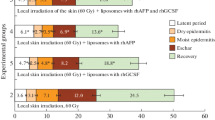Abstract
Murine skin was thermally injured under controlled conditions in a standard high temperature burn model. After high-speed homogenization of the burned skin, a toxic fraction was isolated applying different purification procedures. It was demonstrated that high temperature burns produced chemical condensations and high molecular aggregates in the protein moiety of the skin. Plasma proteins were involved in these reactions. After the purification process, the high molecular aggregates were obtained not as pure proteins, but as lipid-protein micelles. In the lipid moiety itself, thermal decomposition products were detectable. The biological effects of the purified lipid-protein fraction were studied by aid of rat liver perfusions 5 days after intraperitoneal injection of the material measuring different biosynthetic activities of the isolated organ. Significantly reduced biosynthesis of urea and depressed gluconeogenesis were demonstrable. The biochemical results are paralleled by ultrastructural findings indicating that the lipid-protein complex from burned skin causes mitochondrial vacuolization in liver cells of treated animals.
Résumé
Chez des souris, une brûlure cutanée a été réalisée dans des conditions contrôlées et avec un modèle standard de brûlure à haute température. Après homogénéisation à grande vitesse de la peau brûlée, une fraction toxique a été isolée par différentes techniques de purification. Nous avons démontré qu'une brûlure à température élevée produit des condensations chimiques et des aggrégats macromoléculaires dans la fraction protéinique de la peau. Les protéines plasmatiques jouent un rôle dans ces réactions. Après purification, les aggrégats macromoléculaires sont récoltés, non pas sous forme de protéines pures, mais sous forme de micelles lipo-protéiniques. Dans la fraction lipidique, on trouve des produits de décomposition thermique. Les effets biologiques de la fraction lipoprotéinique purifiée ont été étudiés sur une perfusion de foie de rat, 5 jours après injection intrapéritonéale du produit; plusieurs activités de biosynthèse du foie isolé ont été étudiées. Nous avons observé une nette réduction de la synthèse de l'urée et une dépression de la glyconéogenèse. Ces résultats biochimiques concordent avec des modifications de l'ultrastructure cellulaire: le complexe lipo-protéinique de la peau brûlée produit une vacuolisation des mitochondries des cellules hépatiques.
Similar content being viewed by others
References
Cuthbertson, D.P.: Modern review of the disturbed metabolism consequent on thermal burning. J. R. Coll. Surg. Edinb.15:239, 1970
Harrison, H.N., Moncrief, J.A., Duckett, J.W., Mason, A.D.: The relationship between energy metabolism and water loss from evaporization in severely burned patients. Surgery56:203, 1964
Moyer, C.A.: In Research in Burns, Artz, C.P., editor. Washington, American Institute of Biological Sciences, 1962
Roe, C.F., Kinney, J.M., Blair, C.: Water and heat exchange in third-degree burns. Surgery56:212, 1964
Zawacki, B.E., Spitzer, W., Mason, A.D., Johns, L.A.: Does increased evaporative water loss cause hypermetabolism in burned patients? Ann. Surg.171:236, 1970
Städler, K., Allgöwer, M., Cueni, L., Schoenenberger, G.A.: Pathophysiologische Untersuchungen an einem Verbrennungs-modell der Maus. Res. Exp. Med. (Berl.)158:23, 1972
Schoenenberger, G.A.: Burn toxins isolated from mouse and human skin, their characterization and immunotherapy effects. Monogr. Allergy6:72, 1975
Davis, B.J.: Disc electrophoresis. Method and application to human serum proteins. Ann. N.Y. Acad. Sci.121:404, 1964
Ornstein, L.: Disc electrophoresis. Background and theory. Ann. N.Y. Acad. Sci.121:321, 1964
Neville, D.M.: Fractionation of cell wall membrane protein by disc electrophoresis. Biochim. Biophys. Acta133:168, 1967
Minchin-Clarke, H.G., Freeman, T.: Quantitative immuno-electrophoresis of human serum proteins. Clin. Sci.35:304, 1968
Schimassek, H.: Perfusion of isolated rat liver with a semisynthetic medium and control of liver function. Life Sci.11:629, 1962
Rosenthal, S.R.: The toxin of burns. Ann. Surg.106:257, 1937
Baxter, C.R., Cook, W.A., Shires, G.T.: Serum myocardial depressant factor of burn shock. Surg. Forum17:1, 1966
Hakim, A.A.: Thermal injury: release of a cytotoxic factor. Experientia29:865, 1973
Fedorow, H.A., Mowshew, B.E., Nedoshiwina, R.W., Petrow, W.N., Awertschenko, W.I.: Isolation and study of toxic fractions from burnt skin. Vopr. Med. Khim.20:371, 1974
Allgöwer, M., Städler, K., Schoenenberger, G.A.: Burn sepsis and burn toxin. Ann. R. Coll. Surg. Engl.55:226, 1974
Bekhum, D.W., Peters, R.A.: Observation upon a change in an enzymatic process in burns. Q.J. Exp. Physiol.36:127, 1951
Kröner, H., Beien, J., Staib, W.: Tierexperimentelle Untersuchungen zum Protein- und Aminosäurenstoffwechsel nach standardisierten Verbrennungen. Z. Klin. Chem. Klin. Biochem.9:314, 1971
Author information
Authors and Affiliations
Rights and permissions
About this article
Cite this article
Schmidt, K., Schölmerich, J., Kremer, B. et al. Studies on the structure and biological effects of pyrotoxins purified from burned skin. World J. Surg. 3, 361–365 (1979). https://doi.org/10.1007/BF01556594
Issue Date:
DOI: https://doi.org/10.1007/BF01556594




